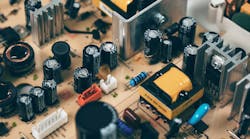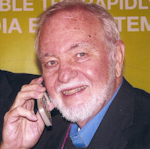The History of Personal Computers – Part 1: The East Coast Version
>> Electronic Design Resources
.. >> Library: Article Series
.. .. >> Topic: Looking Back at Electronic History
.. .. .. >> The History of Personal Computers
Have you ever wondered where PCs and all their derivatives came from? If not, I am going to tell you anyway, at least my version of it. Of course, the source was the development of the microprocessor in the early 1970s.
One of the things that really ticks me off is to hear that the PC had its start in Silicon Valley. Naturally, much of the development occurred there but lots went on outside of the west coast. If you read the book Fire in the Valley (Osborne/McGraw Hill, 1984) you get the impression that the whole PC and hobby computing movement occurred in Silicon Valley and that Steve Wozniak and Steve Jobs invented the PC and Bill Gates invented software. But there is more to the story than that.
My first remembrance of a hobby computer movement was in the late 1960s when I first subscribed to Stephen B. Grey’s Amateur Computer Society newsletter. The microprocessor hadn’t been invented yet and the big computing boom was in minicomputers made by Digital Equipment Corporation (DEC), Data General and others. They were made with ICs and discretes and were horrendously expensive. DEC made the cheapest mini called a PDP-8E for about $9000. A small hardy group of electronic hobbyists were trying to build their own computers out of cheap digital ICs (RTL and DTL mostly) and surplus magnetic core memories out of old IBM 1620 computers. Solid state memory was not available yet. The ACS newsletter served as an information source on ICs, memories and potential I/O terminal devices.
In the late 1960s and early 1970s, a couple of computer kits came into being. One was the Kenback made with 7400 series TTL. An educational training computer by Fabri-Tek called the BiTran 6 was available to schools and the military. I developed a computer kit for McGraw Hill’s National Radio Institute (NRI) in 1972 using TTL called the 832. It used a 16 word 8-bit programmable ROM made with slide switches. Another 16 words of RAM was a pair of 7489s TTL 64-bit SRAM. There were 8 instructions, a serial CPU and a clock of 500 kHz. We sold several thousand of them as part of a home study course in computer technology. It worked great and was a great training device. It is amazing what you can program in just 32 words.
Other kit computers came along in 1974 like the Scelbi-8H, a kit based on Intel’s first 8-bit micro the 8008. Also in 1974, Radio-Electronics magazine published an article on the Mark-8 a computer also based on the 8008. Radio-Electronics also published an article on how to make a video terminal with a TV set. Written by Don Lancaster, the article described a TV Typewriter and the article was eventually expanded into a book by SAMS.
The Intel 8080 arrived in the 1974 time period and that really changed things. The first real 8080 kit named the Altair 8800 came from an Albuquerque company called MITS. It was featured on the cover of Popular Electronics magazine and generated massive interest and sales. It was just a box with CPU and RAM on a bus that became known as the S-100 bus. Programming was in hex with front panel binary lights and switches. A similar machine was also available from IMSAI. I had one of these in 1976 with a Teletype ASR-33 terminal. Programming was in BASIC using paper tape I/0. Slow and primitive but it did work. The most popular accessory was 4K (yes, 4KB) memory boards.
All hell broke loose after that. Dozens of computer kits came and went, most using the 8080 or later the Z80. Some used the Motorola 6800. The MOS Technology 6502 was also popular (Commodore, KIM and Apple). Program storage was on an audio cassette using the so-called Tarbell Kansas City standard. It was primitive but very effective for such low cost.
It was during the 1975-1977 time period all sorts of new computers came along the most notable being the Apple I followed by the Apple II, the Radio Shack TRS-80, and the Commodore PET. The OS and language was BASIC. Packaged applications software became available. I think the Apple II became such a hit mainly because of a fabulous program called VisiCalc. Remember that? The first spreadsheet.
Hard disks were not popular because of the cost. You could get 8” floppy for some machines. The 5” mini drives came along later and became popular because of their lower cost. Gary Kildall wrote his famous CP/M operating system for the 8080. Adam Osborne made the first portable PC with an 8080 and CP/M.
A whole slew of small cheap game computers emerged next. Remember the Atari 400/800, the Commodore 32, the Sinclair ZX-81 or the Texas Instruments 99/4?
Magazines, computer shows and clubs drove the whole movement. Some of the magazines were Byte, Kilobaud, Creative Computing, Dr. Dobbs Journal, and Interface Age. I wrote for Interface Age for a while. The very first computer show was put together by John Dilks in 1976 in Atlantic City, NJ. MITS put on an Altair conference in Albuquerque in 1976 as well. Jim Warren created the first West Coast Computer Faire in 1977. I went to all three shows. Local clubs sprang up everywhere. And computer stores became a new retail outlet.
I lost track of all the S-100 bus PCs that were made. All are history today. Intel finally announced the 8088 and 8086 16-bit processors in the late 1970s. The IBM PC came along in August of 1981. I got one in December. The IBM PC changed everything. Suddenly it was no longer a hobby business. And the rest, as they say, is history.
One final point. The computer business really developed on the east coast thanks to IBM, DEC, Burroughs, Univac, Data General, and other big mainframe and minicomputer computer manufacturers. Most semiconductor development went on in Silicon Valley, obviously, but much of the computer business itself was elsewhere, less one forgets. I guess that’s history for you. Everyone involved has their own view of it. The truth lies in many places in many forms.
As for Heathkit, that is another whole story I will tell you next time.
>> Electronic Design Resources
.. >> Library: Article Series
.. .. >> Topic: Looking Back at Electronic History
.. .. .. >> The History of Personal Computers

